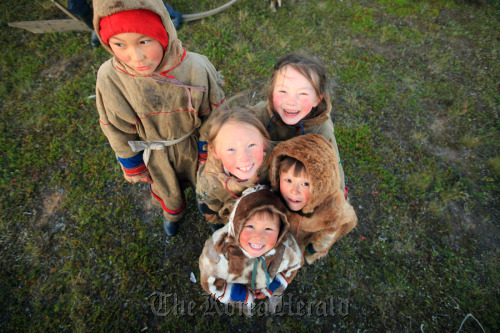Documentary ‘The Last Tundra’ shows culture’s respect for nature
By 김후란Published : Feb. 13, 2011 - 19:28
They follow the stars and the moon when they travel, melt gigantic pieces of ice for drinking water, and use natural moss for baby diapers and dish washing ― all in minus-50 degree weather.
SBS documentary “The Last Tundra ― Movie Edition” offers a very rare glimpse into the life of the Nenets, the last reindeer herding nomads living in Siberian tundra.
Through a yearly migration of more than a thousand kilometers, the Nenets live in one of the harshest environments on earth, keeping a regimented work ethic as well as rich and robust culture of their own.
Narrated by actress Ko Hyeon-jeong, the documentary not only captures the life of the Nenets, but Siberian tundra’s breathtakingly beautiful nature ― including its fascinating aurora at night and the glowing midnight sun in the summer months.
SBS documentary “The Last Tundra ― Movie Edition” offers a very rare glimpse into the life of the Nenets, the last reindeer herding nomads living in Siberian tundra.
Through a yearly migration of more than a thousand kilometers, the Nenets live in one of the harshest environments on earth, keeping a regimented work ethic as well as rich and robust culture of their own.
Narrated by actress Ko Hyeon-jeong, the documentary not only captures the life of the Nenets, but Siberian tundra’s breathtakingly beautiful nature ― including its fascinating aurora at night and the glowing midnight sun in the summer months.

The movie was entirely shot using Canon EOS 5D Mark 2, a DSLR camera with a movie recording feature that can film in full HD at 1920 x 1080 resolution.
The camera’s portable size made it easier for the filming crew to work in tundra’s severe weather, and let the Nenets feel more comfortable while being filmed.
The TV edition of the film was broadcast from November to December, divided into four separate episodes. Jang Kyung-soo, one of the two directors of the documentary, said it took him a long time to decide how to differentiate the movie from its TV version.
“I was either going to make this movie with the material that I didn’t use for the TV edition, or just to go with the original message I had when I started the project,” Jang said at a press conference in Seoul on Feb. 9.
“Then I came to a conclusion to show the ways of life of the Nenets through the four different seasons.”
The 300-day filming process was far from easy. Aside from tundra’s harsh weather ― which Jang described as “skin-cutting cold”― the documentary crew suffered from not having access to one of the most important places in life ― the bathroom.
“Every member of the crew suffered from constipation for at least 15 days,” Jang said, laughing.
Jang said he’d like his viewers to find the movie’s embedded meaning, especially the natural environment of the tundra threatened by the Russian government’s gas development.
The movie also sheds light on Russia’s systemic cultural assimilation of the Nenets, through Grecia and Goria, the two Nenet children featured in the film.
The two boys ― Grecia, 7, and Goria, 6 ― love eating snow and play with reindeer and other animals in tundra. They are extremely strong and independent considering their age, taught by nature to coexist with all other living things in the region.
It is almost heartbreaking to see the strong Goria break down in tears on his first day of boarding school in the city. Since the 1930s, the Soviet government has made it mandatory for the Nenets to attend the nation’s boarding schools between the ages of 6 to 16. The kids can only visit their tundra home during school breaks.
The last question of the documentary asks what the tundra will be like when Goria and Grecia permanently return there after they complete their Russian education. The question lingers, as yet unanswered.
“The Last Tundra” opens in theaters on Feb. 17.
By Claire Lee (clairelee@heraldcorp.com)









![[Kim Seong-kon] Democracy and the future of South Korea](http://res.heraldm.com/phpwas/restmb_idxmake.php?idx=644&simg=/content/image/2024/04/16/20240416050802_0.jpg&u=)







![[KH Explains] Hyundai's full hybrid edge to pay off amid slow transition to pure EVs](http://res.heraldm.com/phpwas/restmb_idxmake.php?idx=652&simg=/content/image/2024/04/18/20240418050645_0.jpg&u=20240418181020)

![[Today’s K-pop] Zico drops snippet of collaboration with Jennie](http://res.heraldm.com/phpwas/restmb_idxmake.php?idx=642&simg=/content/image/2024/04/18/20240418050702_0.jpg&u=)